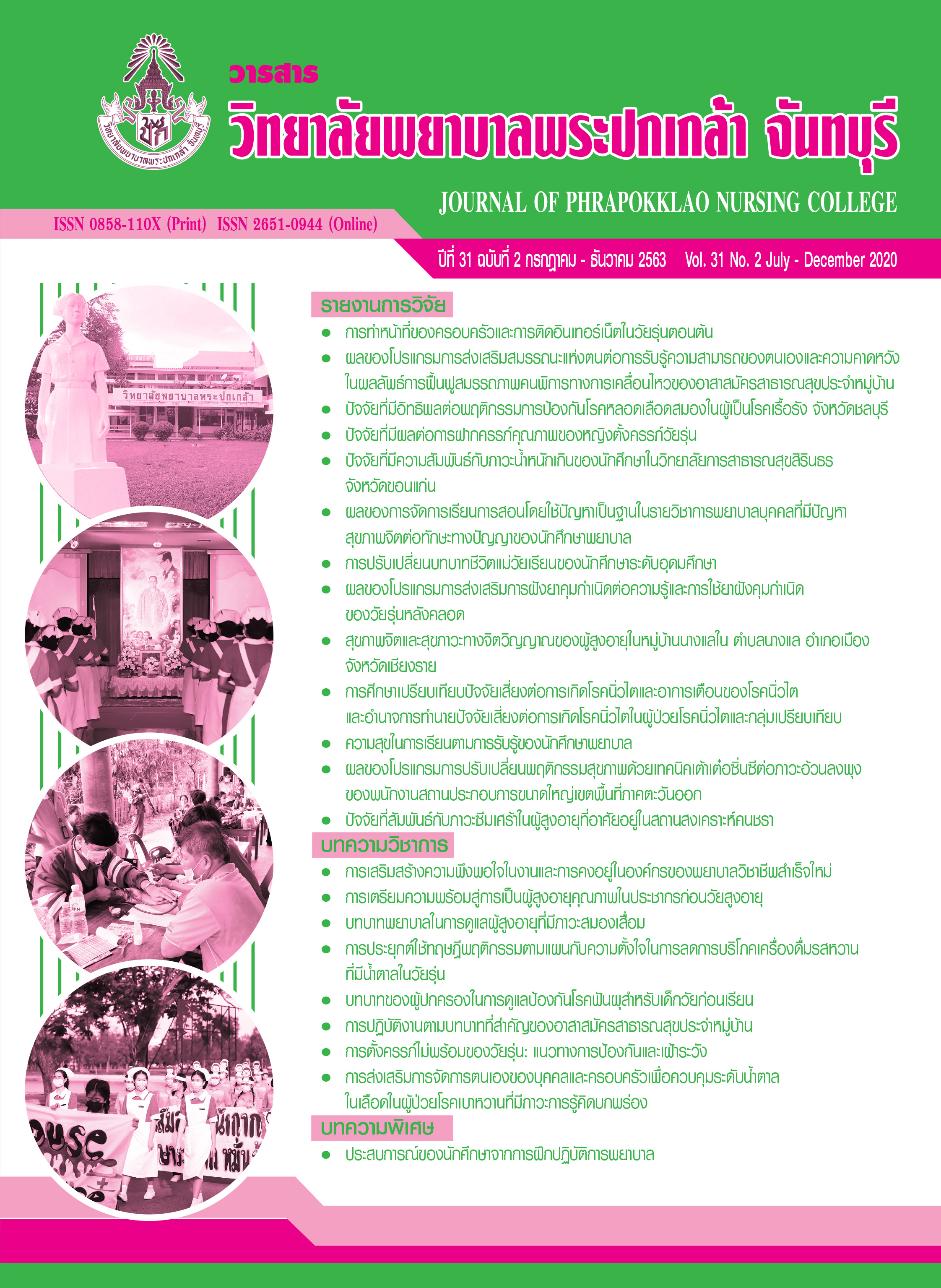Family Function and Internet Addiction among Early Adolescents
Keywords:
Family function, Internet addiction, Early adolescentAbstract
This descriptive correlational research aimed to examine the relationship between family function and internet addiction among early adolescents. The samples consisted of 430 early adolescents aged 12–15 years, studying at schools in Chiang Mai Province. The research instruments consisted of the demographic questionnaire, the Chulalongkorn Family Inventory with the reliability of .82, and the Internet Addiction Test with the reliability of .89. Data were collected from January to March, 2019. Statistics used for data analysis included frequency, percentage, mean, standard deviation, and Spearman rank correlation.
The research results revealed that family function was positively statistically significant related to internet addiction among early adolescents (rs = .150, p < .05).
This research suggests that nurses and related personnel working with adolescents should monitor adolescents’ internet addiction and give an appropriate assistance as well as promote the family functions among adolescents in order to reduce the internet addiction problem.
References
ธานินทร์ สุธีประเสริฐ, ธนพร ศักดิ์ศรีสนอง, สุรีย์พร เต๊ะดอเลาะ, วัชรินทร์ โกมลมาลัย, สุวัฒนา เกิดม่วง, สุนิสา จันทร์แสง, และศักดิกร สุวรรณเจริญ. (2561). พฤติกรรมการเล่นเกมและการติดเกมของนักเรียนระดับมัธยมศึกษาตอนต้น โรงเรียนแห่งหนึ่งในอำเภอบางบัวทอง จังหวัดนนทบุรี. วารสารการพัฒนาสุขภาพชุมชน มหาวิทยาลัยขอนแก่น, 6(1), 68–76.
บุญญรัตน์ นทีสถิตย์ธาร. (2559). พฤติกรรมและผลกระทบในการใช้อินเทอร์เน็ตประกอบการเรียนของโรงเรียนสิงห์บุรี (การค้นคว้าอิสระปริญญามหาบัณฑิต). ปทุมธานี: มหาวิทยาลัยเทคโนโลยีราชมงคลธัญบุรี.
บุญใจ ศรีสถิตย์นรากูร. (2553). ระเบียบวิธีการวิจัยทางพยาบาลศาสตร์ (พิมพ์ครั้งที่ 5). กรุงเทพฯ: ยู แอนด์ ไอ อินเตอร์ มีเดีย.
ผจงจิต ผาภูมิ. (2546). การติดคอมพิวเตอร์/อินเตอร์เน็ต และแนวทางการป้องกัน แก้ไข. วารสารสุขภาพจิตแห่งประเทศไทย, 11(1), 41–54.
ภูเบศร์ สมุทรจักร, ธีรนุช ก้อนแก้ว, และริฎวัน อุเด็น. (2560). ความอยู่ดีมีสุขของครอบครัวไทย. นครปฐม: สถาบันวิจัยประชากรและสังคม มหาวิทยาลัยมหิดล.
ศุภทัต แดงเครื่อง. (2555). ความสัมพันธ์ระหว่างพฤติกรรมการติดอินเทอร์เน็ตกับความเหงาและทักษะทางสังคมของวัยรุ่น: กรณีศึกษานักเรียนระดับมัธยมศึกษาในเขตภาคเหนือตอนบน (วิทยานิพนธ์ปริญญามหาบัณฑิต). มหาวิทยาลัยเชียงใหม่.
อุมาพร ตรังคสมบัติ. (2554). จิตบำบัดและการให้คำปรึกษาครอบครัว (พิมพ์ครั้งที่ 6). กรุงเทพฯ: ซันต้าการพิมพ์.
Bonnaire, C., & Phan, O. (2017). Relationships between parental attitudes, family functioning and internet gaming disorder in adolescents attending school. Psychiatry Research, 255, 104–110.
Chak, K., & Leung, L. (2004). Shyness and locus of control as predictors of internet addiction and internet use. Cyberpsychology & Behavior, 7(5), 559–570.
Epstein, N. B., Baldwin, L. M., & Bishop, D. S. (1983). The McMaster Family Assessment Device. Journal of Marital and Family Therapy, 9(2), 171–180.
Epstein, N. B., Bishop, D., Ryan, C., Miller, I. W., & Keitner, G. I. (1993). The McMaster model view of healthy family functioning. In F. Walsh (Ed.), Normal family processes (pp. 138–160). New York: Guilford.
Farrington, D. P. (1995). The development of offending and antisocial behaviour from childhood: Key findings from the Cambridge Study in Delinquent Development. Journal of Child Psychology and Psychiatry, 36, 929–964.
Gunuc, S., & Dogan, A. (2013). The relationships between Turkish adolescents’ internet addiction, their perceived social support and family activities. Computers in Human Behavior, 29(6), 2197–2207.
Habibi, A., Danesh, P., & Mazandarani, M. J. Z. (2015). The relationship of family function with internet addiction among girl high school students in Malard. Mediterranean Journal of Social Sciences, 6(4), 215–222.
Internet World Stats. (2018). Internet world stats usage and population statistics. Retrieved from https://www.internetworldstats.com
Krejcie, R. V., & Morgan, D. W. (1970). Determining sample size for research activities. Educational and Psychological Measurement, 30(3), 607–610.
Kuss, D. J., Griffiths, M. D., Karila, L., & Billieux, J. (2014). Internet addiction: A systematic review of epidemiological research for the last decade. Current Pharmaceutical Design, 20(25), 4026–4052.
Mak, K. K., Lai, C. M., Watanabe, H., Kim, D. I., Bahar, N., Ramos, M., … Cheng, C. (2014). Epidemiology of internet behaviors and addiction among adolescents in six Asian countries. Cyberpsychology, Behavior and Social Networking, 17(11), 720–728.
Pontes, H. M., Kuss, D. J., & Griffiths, M. D. (2015). Clinical psychology of internet addiction: A review of its conceptualization, prevalence, neuronal processes, and implications for treatment. Neuroscience & Neuroeconomics, 4, 11–23.
Ryan, T. A. (2015). Facebook addiction: An exploratory study using mixed methods (Doctoral dissertation). Royal Melbourne Institute of Technology.
Santrock, J. W. (2014). Adolescence. New York: McGraw-Hill Education.
Tao, L., & Lanjun, Z. (2004). How college students’ internet addiction are related to parental rearing patterns. Psychological Science (China), 27(3), 662–663.
Telef, B. B. (2016). Investigating the relationship among internet addiction, positive and negative affects, and life satisfaction in Turkish adolescents. International Journal of Progressive Education, 12(1), 128–135.
Wong, T. Y., Yuen, K. S. L., & Li, W. O. (2015). A basic need theory approach to problematic internet use and the mediating effect of psychological distress. Frontiers in Psychology, 5, 1562.
Wu, C. S. T., Wong, H. T., Yu, K. F., Fok, K. W., Yeung, S. M., Lam, C. H., & Liu, K. M. (2016). Parenting approaches, family functionality, and internet addiction among Hong Kong adolescents. BMC Pediatrics, 16(1), 130.
Xin, M., Xing, J., Pengfei, W., Houru, L., Mengcheng, W., & Hong, Z. (2017). Online activities, prevalence of internet addiction and risk factors related to family and school among adolescents in China. Addictive Behaviors Reports, 7, 14–18.
Young, K. S. (1998). Internet addiction: The emergence of a new clinical disorder. Cyberpsychology & Behavior, 1(3), 237–244.
Downloads
Published
How to Cite
Issue
Section
License
Copyright (c) 2020 JOURNAL OF PHRAPOKKLAO NURSING COLLEGE

This work is licensed under a Creative Commons Attribution-NonCommercial-NoDerivatives 4.0 International License.
เนื้อความ ข้อมูล และรายการอ้างอิงที่ผู้เขียนใช้ในการเขียนบทความเพื่อลงตีพิมพ์ในวารสารวิทยาลัยพยาบาลพระปกเกล้า จันทบุรี ถือเป็นความคิดเห็นและความรับผิดชอบของผู้เขียน คณะผู้จัดทำวารสารไม่จำเป็นต้องเห็นพ้องด้วยหรือร่วมรับผิดชอบ
บทความที่ได้รับการลงตีพิมพ์ในวารสารวิทยาลัยพยาบาลพระปกเกล้า จันทบุรี ถือเป็นลิขสิทธิ์ของวารสารวิทยาลัยพยาบาลพระปกเกล้า จันทบุรี หากหน่วยงานหรือบุคคลใดต้องการนำส่วนหนึ่งหรือทั้งหมดของบทความไปเผยแพร่ต่อเพื่อวัตถุประสงค์ใด ๆ จะต้องได้รับอนุญาตจากบรรณาธิการวารสารก่อน



